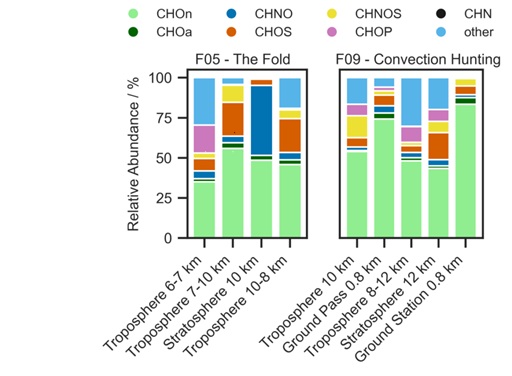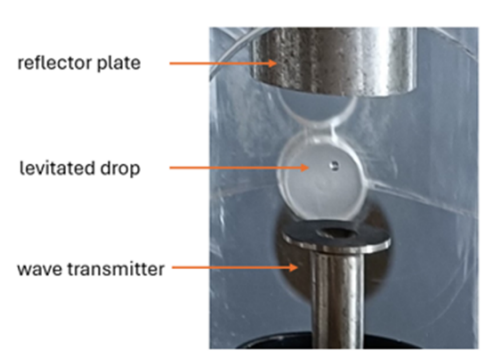
Observational Data
Some examples of observational data sets used within TPChange:
Airborne measurements
LearJet
- UMAQS: CO and N2O
- Ozone
- Mini-AMS: aerosol composition
- NIXE-Cups
- FISH: Water vapor and total water
- Sampler for Organic Aerosol Particles (SOAP)
SOAP allows the collection of five aerosol filter samples during a flight, e.g., during TPEx. These
samples are further analyzed to determine the organic aerosol fraction, using ultra-high
performance liquid chromatography (UHPLC), coupled with high-resolution Orbitrap-mass
spectrometry (HRMS).

Relative abundance in % of the elemental composition groups CHOn, CHOa, CHNO, CHOS, CHNOS, CHOP, CHN and other, measured with Orbitrap mass spectrometry in negative ionization mode (also given in Table 2). Displayed are the filters that were sampled throughout the flights F05 and F09. In panel F09, the filter sampled at the ground station Taunus Observatory is added. (Figure 3 in Breuninger et al., 2025)
TPC-TOSS (see also Bozem et al., 2025)
HALO
IAGOS-Core
IAGOS-CORE cooperates with several airlines for quasi-continuous measurements of trace gases, aerosol and cloud particles from a fleet of long-haul passenger aircraft. Each aircraft is equipped with the IAGOS-CORE rack which contains all necessary provisions for installing fully automated instruments (Package 1) for the measurement of ozone, carbon monoxide, humidity (ICH) and cloud particles (BCP). For the second instrument (Package 2) several options have been developed: Package2a for measurements of total odd nitrogen (NOy), Package2b for nitrogen oxides (NOx), Package2c for aerosol, and Package2d for greenhouse gases (CO2 and CH4) and package 2e (air quality) for aerosols and nitrogen dioxide (NO2). Only one option can be installed at a time in a given aircraft. For details of the different instruments click on the unit names in the Table below.
The IAGOS-CORE measurement units are:
| Unit | Measured Variables | Responsible Member |
| Package1 | ozone, carbon monoxide | CNRS |
| ICH | water vapour | FZJ |
| BCP | number density of cloud particles | UMAN |
| Package2a | Total odd nitrogen (NOy) | FZJ |
| Package2b | nitrogen oxides (NOx) | FZJ |
| Package2c | aerosol number density and size distribution | FZJ |
| Package2d | carbon dioxide, methane, carbon monoxide, water vapour | MPI-BGC |
| Package2e | Aerosols and nitrogen dioxide | FZJ |
IAGOS-CARIBIC
IAGOS-CARIBIC is part of the European Research Infrastructure IAGOS which operates
instrumentation for atmospheric observations on board of passenger aircraft of commercial
airlines. The project name is an acronym for ‚Civil Aircraft for the Regular Investigation of the
Atmosphere Based on an Instrument Container‘.
In IAGOS-CARIBIC, a complex laboratory equipped with ~20 instruments is deployed in the
cargo bay of a modified Airbus by Lufthansa during long-distance flights from Europe to many
destinations worldwide. Around 100 trace gases, aerosol and cloud parameters are measured
with the focus on an improved monitoring and understanding of many climate-relevant
processes in the free atmosphere.
Until now IAGOS-CARIBIC had two successful deployments:
CARIBIC-1: A strongly modified LD4 airfreight container with 6 instruments (including a big
air sampler) was operated on board a Boeing-767ER of LTU airlines. Due to financial
problems of LTU, measurement flights were stopped in April 2002.
CARIBIC-2: A strongly modified LD11 airfreight container with finally 19 instruments in 9
racks was operated on board a Airbus A340-600 by Lufthansa airlines. The total weight
was 1.6 t (including the laboratory infrastructure with e.g. master/control computer, gas
rack, central power unit, etc. Driven by the Corona pandemic Lufthansa phased-out the
A340-600.
Currently, phase 3 is in preparation.
Balloon-borne measurements
- Radiosonde measurements
- AirCore measurements
Drone measurements

The Flying Laboratory (FLab), figure modified after Fig. 1 in Moormann et al., 2025
Laboratory measurements
Mainz – Acoustic Leviator
Prozesses related to cloud droplets, e.g., riming or freezing are studied with the Mainz-Acoustic
leviator in the laboratory
Droplet in the acoustic leviator. Modified from Fig. 1 in Gautam et al., 2024Droplet in the acoustic leviator. Modified from Fig
Droplet in the acoustic leviator. Modified from Fig. 1 in Gautam et al., 2024
The Mainz Vertical Wind Tunnel
